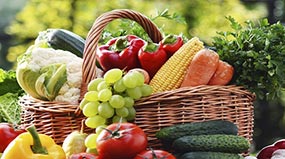Key points
- Fruits and vegetables provide essential vitamins and minerals, fiber, and other substances important for good health.
- Incorporating more fruits and vegetables is a healthy way to lose or maintain weight.

To lose weight, eat fewer calories than your body uses
Losing weight doesn't necessarily mean that you have to eat less food. You can create lower-calorie versions of some of your favorite dishes by substituting low-calorie fruits and vegetables in place of higher-calorie ingredients.
Most fruits and vegetables are naturally low in fat and calories. The water and fiber in fruits and vegetables will add volume to your dishes so you can eat the same amount of food with fewer calories. This means you can feel full while eating fewer calories.
Healthy eating is important for good health.
Eat more fruits and vegetables throughout the day
Breakfast — start the day right
Substitute spinach, onions, or mushrooms for one egg or half the cheese in your morning omelet. The vegetables will add volume and flavor to the dish with fewer calories than the egg or cheese.
Cut back on the amount of cereal in your bowl to make room for bananas, peaches, or strawberries. You can still eat a full bowl of food but with fewer calories.
Lighten up your lunch
Substitute vegetables such as lettuce, tomatoes, or cucumbers for some of the cheese and meat in your sandwich, wrap, or burrito. Or, replace 2 ounces of meat or 1 cup of noodles in soup with 1 cup of chopped vegetables, such as broccoli, carrots, beans, or red peppers. The new version will fill you up with fewer calories than the original.
Dinner
Replace 1 cup of rice or pasta in your favorite dish with 1 cup of vegetables such as broccoli, squash, or peppers. The dish with the vegetables will be just as satisfying but have fewer calories than the same amount of the original version.
Take a good look at your dinner plate. Vegetables, fruit, and whole grains should take up the largest portion of your plate. If they do not, replace some of the meat, cheese, white pasta, or rice with legumes, steamed broccoli, asparagus, greens, or another favorite vegetable. This will reduce the total calories in your meal without reducing the amount of food you eat.
Remember to use a normal- or small-size plate — not a platter. The total number of calories you eat counts, even if a good proportion of them come from fruits and vegetables.
Smart snacks
Instead of high-calorie snacks such as corn chips, take healthy snacks with you when you're on the go. If you are aiming for snacks with 100 calories or less, consider:
- A medium apple (72 calories)
- A medium banana (105 calories)
- One cup steamed green beans (44 calories)
- One cup blueberries (83 calories)
- One cup grapes (100 calories)
- Two tablespoons of hummus (46 calories) with:
- 1 cup carrots (45 calories)
- 1 cup broccoli (30 calories) or
- 1 cup bell peppers (30 calories)
- 1 cup carrots (45 calories)
More tips
Eat fruits and vegetables uncooked or with fat-free or low-fat cooking techniques. Try steaming your vegetables, using low-calorie or low-fat dressings, and using herbs and spices to add flavor. Some cooking techniques, such as breading and frying, or using high-fat dressings or sauces will greatly increase the calories and fat in the dish. Also, eating raw fruit lets you enjoy its natural sweetness.
Canned or frozen fruits and vegetables are also good options. Frozen or canned fruits and vegetables can be just as nutritious as the fresh varieties. However, be careful to choose those without added sugar, syrup, cream sauces, or other ingredients that will add calories.
Choose whole fruits over fruit drinks and juices. Fruit juices have lost fiber from the fruit. It is better to eat the whole fruit because it contains the added fiber that helps you feel full.
Whole fruit gives you a bigger snack than dried fruit. For example, a small box of raisins (1/4 cup) is about 100 calories. For the same number of calories, you can eat 1 cup of grapes and feel more full.
Substitution is key

While fruits and vegetables are lower in calories than many other foods, they do contain some calories. If you start eating fruits and vegetables in addition to what you usually eat, you are adding calories and may gain weight. The key is substitution. Eat fruits and vegetables instead of some other higher-calorie food.
Resources
Cut Down on Added Sugars offers ways to cut back on added sugar.
MyPlate Plan provides tips for developing a personalized plan within your food preferences, health goals, and budget.
Start Simple with MyPlate app helps you pick simple daily food goals and see real-time progress.
